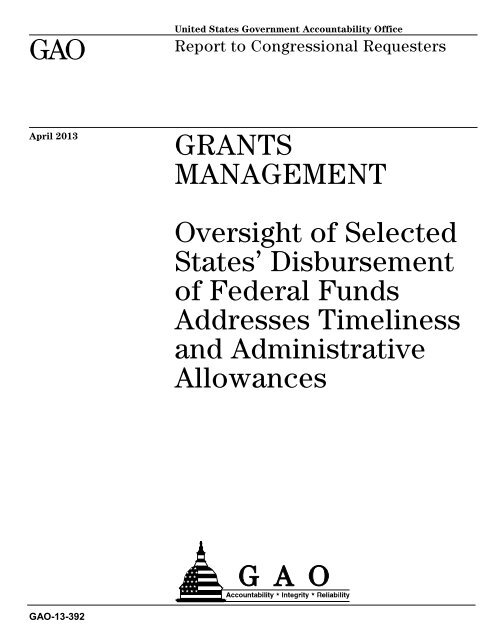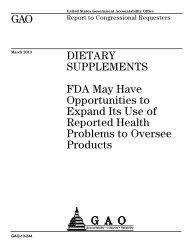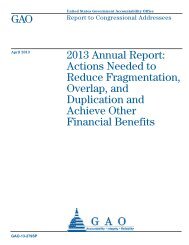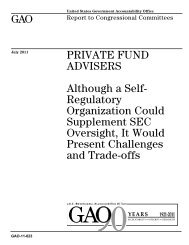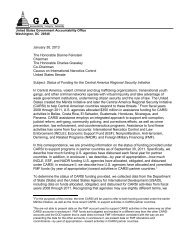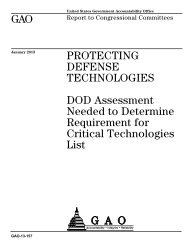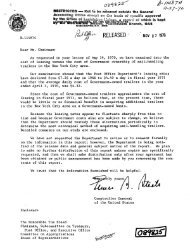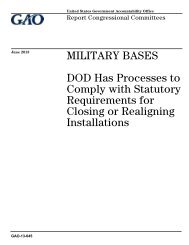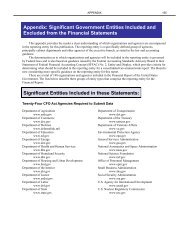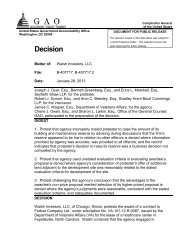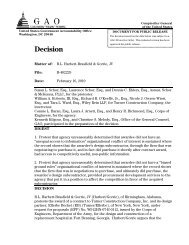GAO-13-392, Grants Management - US Government Accountability ...
GAO-13-392, Grants Management - US Government Accountability ...
GAO-13-392, Grants Management - US Government Accountability ...
Create successful ePaper yourself
Turn your PDF publications into a flip-book with our unique Google optimized e-Paper software.
<strong>GAO</strong><br />
United States <strong>Government</strong> <strong>Accountability</strong> Office<br />
Report to Congressional Requesters<br />
April 20<strong>13</strong><br />
GRANTS<br />
MANAGEMENT<br />
Oversight of Selected<br />
States’ Disbursement<br />
of Federal Funds<br />
Addresses Timeliness<br />
and Administrative<br />
Allowances<br />
<strong>GAO</strong>-<strong>13</strong>-<strong>392</strong>
Highlights of <strong>GAO</strong>-<strong>13</strong>-<strong>392</strong>, a report to<br />
congressional requesters<br />
April 20<strong>13</strong><br />
GRANTS MANAGEMENT<br />
Oversight of Selected States’ Disbursement of<br />
Federal Funds Addresses Timeliness and<br />
Administrative Allowances<br />
Why <strong>GAO</strong> Did This Study<br />
Grant programs in which states are<br />
awarded federal grants but then pass<br />
funds on to subrecipients—entities<br />
within states’ jurisdiction—are referred<br />
to as “pass-through grants.” These<br />
relationships pose challenges for the<br />
management of grant programs, as the<br />
multiple levels add complexity to the<br />
flow of funds, administration, and<br />
oversight.<br />
As requested, <strong>GAO</strong> examined<br />
management and oversight of passthrough<br />
grants. This report addresses<br />
(1) requirements and oversight related<br />
to the timeliness of federal grant funds<br />
from states to subrecipients and the<br />
portion states may withhold for their<br />
administration, (2) select states'<br />
practices in disbursing federal grant<br />
funds to subrecipients and the extent<br />
to which select federal granting<br />
agencies have identified compliance<br />
issues with these requirements, and<br />
(3) the views of subrecipients on the<br />
impact of selected states’ practices in<br />
disbursing grant funds. To conduct this<br />
study, <strong>GAO</strong> selected states and<br />
programs based on characteristics<br />
affecting pass-through grants<br />
management. <strong>GAO</strong> reviewed<br />
documentation on government-wide<br />
regulations and selected federal passthrough<br />
grant programs; reviewed<br />
monitoring reports and audits of state<br />
pass-through entities; and interviewed<br />
federal and state officials, as well as<br />
subrecipients and others with relevant<br />
expertise. Findings cannot be<br />
generalized to all states and programs,<br />
but our work provides insights related<br />
to pass-through grants management.<br />
<strong>GAO</strong> makes no recommendations in<br />
this report. OMB and selected federal<br />
granting agencies provided technical<br />
comments, which were incorporated as<br />
appropriate<br />
View <strong>GAO</strong>-<strong>13</strong>-<strong>392</strong>. For more information,<br />
contact Stanley J. Czerwinski at (202) 512-<br />
6806 or czerwinskis@gao.gov.<br />
What <strong>GAO</strong> Found<br />
As pass-through grant funds flow to subrecipients, they are subject to<br />
government-wide and program-specific policies, two of which are particularly<br />
relevant to disbursement issues for states as they pass funds on to<br />
subrecipients. As shown below, pass-through grants are typically first awarded to<br />
states, local governments, or other entities and then further awarded to<br />
subrecipients. The Cash <strong>Management</strong> Improvement Act governs the exchange of<br />
funds between the federal government and the states and is applicable to<br />
timeliness in the grant disbursement process. In addition, the Office of<br />
<strong>Management</strong> and Budget’s (OMB) Circular No. A-<strong>13</strong>3, Audits of States, Local<br />
<strong>Government</strong>s, and Non-Profit Organizations, provides general guidance on the<br />
roles and responsibilities of the federal awarding agencies and primary recipients<br />
of government funds regarding audit requirements of grantees. Specific program<br />
policies can provide additional requirements for individual grant programs related<br />
to disbursement of funds. For example, as with the programs we reviewed,<br />
authorizing legislation may contain statutory limits on the amount of funds that<br />
states and local governments can withhold from the grant awards for their own<br />
administrative expenses. To ensure states comply with federal requirements and<br />
agency regulations for disbursing federal grant funds, federal agencies monitor<br />
aspects of pass-through grants related to administrative costs that states<br />
withhold and timeliness of reimbursement. According to their monitoring<br />
procedures, selected federal agencies also review the results of states’ “single<br />
audits”—annual audits performed on many recipients of federal funds.<br />
Examples of How Federal Funds Flow through Primary Grant Recipients to Subrecipients<br />
Selected states’ pass-through grant disbursement practices varied for the three<br />
programs <strong>GAO</strong> reviewed, but generally complied with federal requirements. For<br />
example, states had some flexibility in determining whether a grant would be<br />
distributed on a reimbursement basis or through a cash advance. For the<br />
programs and states <strong>GAO</strong> reviewed, <strong>GAO</strong> found that states generally worked<br />
within the federal parameters of their grant programs and reimbursed the<br />
subrecipients within the time allowed in their grant agreements.<br />
Subrecipients in <strong>GAO</strong> focus groups reported minimal issues with timeliness of<br />
federal funds’ reimbursement and administrative funds that states withheld. In<br />
addition, these subrecipients did not report instances in which federal<br />
requirements related to reimbursement timeliness or administrative funds<br />
withheld were not followed and therefore were not impacted by these<br />
requirements not being met.<br />
United States <strong>Government</strong> <strong>Accountability</strong> Office
Contents<br />
Letter 1<br />
Background 4<br />
Both <strong>Government</strong>-wide Policies and Specific Program Policies<br />
Govern Distribution of Pass-Through Grant Funds 7<br />
Selected States’ Pass-Through Grant Disbursement Practices Vary,<br />
but Generally Comply with Federal Requirements 12<br />
Subrecipients in Focus Groups Reported Minimal Issues with<br />
Timeliness of Federal Funds’ Reimbursement and<br />
Administrative Funds that States Withheld 15<br />
Agency Comments and Our Evaluation 17<br />
Appendix I Objectives, Scope, and Methodology 18<br />
Appendix II <strong>GAO</strong> Contact and Staff Acknowledgments 22<br />
Tables<br />
Table 1: Information on Grant Programs Selected for Review 3<br />
Table 2: Frequency of Subrecipient Reimbursement across<br />
Selected States and Federal Grant Programs 12<br />
Table 3: Information on Grant Programs Selected for Review and<br />
Criteria Used to Select Them 19<br />
Table 4: Information on States Selected for Review and Criteria<br />
Used to Select Them 20<br />
Figures<br />
Figure 1: Examples of How Federal Funds Flow through Primary<br />
Grant Recipients to Subrecipients 5<br />
Figure 2: Typical Grant Life Cycle for Pass-Through <strong>Grants</strong> 6<br />
Page i<br />
<strong>GAO</strong>-<strong>13</strong>-<strong>392</strong> Federal Grant Fund Disbursement
Abbreviations<br />
Byrne JAG<br />
CDBG<br />
CMIA<br />
CSBG<br />
DOJ<br />
FFATA<br />
GSA<br />
HHS<br />
HUD<br />
OMB<br />
Treasury<br />
Edward Byrne Memorial Justice Assistance Grant<br />
Community Development Block Grant<br />
Cash <strong>Management</strong> Improvement Act<br />
Community Services Block Grant<br />
Department of Justice<br />
Federal Funding <strong>Accountability</strong> and Transparency Act of<br />
2006<br />
General Services Administration<br />
Department of Health and Human Services<br />
Department of Housing and Urban Development<br />
Office of <strong>Management</strong> and Budget<br />
Department of the Treasury<br />
This is a work of the U.S. government and is not subject to copyright protection in the<br />
United States. The published product may be reproduced and distributed in its entirety<br />
without further permission from <strong>GAO</strong>. However, because this work may contain<br />
copyrighted images or other material, permission from the copyright holder may be<br />
necessary if you wish to reproduce this material separately.<br />
Page ii<br />
<strong>GAO</strong>-<strong>13</strong>-<strong>392</strong> Federal Grant Fund Disbursement
United States <strong>Government</strong> <strong>Accountability</strong> Office<br />
Washington, DC 20548<br />
April 16, 20<strong>13</strong><br />
The Honorable Tom Coburn, M.D.<br />
Ranking Member<br />
Committee on Homeland Security and <strong>Government</strong>al Affairs<br />
United States Senate<br />
The Honorable Susan M. Collins<br />
United States Senate<br />
The Honorable Mark Kirk<br />
United States Senate<br />
Federal grant programs are delivered through a complex set of<br />
mechanisms and often involve multiple layers of government and<br />
nonprofit entities. In fiscal year 2012, at least $79.6 billion 1 in federal<br />
grant funding was passed through states to local governments and<br />
nonprofit organizations that partner with the federal government to deliver<br />
services, such as improving local infrastructure, providing community job<br />
training, or running drug treatment programs. This network of grantors<br />
and grantees provides many services critical to the nation’s interest, and<br />
by leveraging the funds and expertise of entities within the granting<br />
network, these services can be delivered more efficiently. Over the last<br />
several years, current economic conditions have placed financial strain on<br />
all governmental sectors—federal, state, and local—as well as nonprofit<br />
organizations, and the efficient management of these grant programs at<br />
all levels is critical. Further, for grant programs to be successful it is<br />
important to ensure financial and programmatic controls are implemented<br />
while maintaining the viability of the entities within the granting network.<br />
Grant programs in which states are awarded federal grants but then pass<br />
funds on to one or more levels of recipients—referred to as “pass-through<br />
grants”—provide a useful approach to involving key partners, but they<br />
also present administration challenges. These pass-through grants use<br />
entities such as local governments and nonprofit organizations that are<br />
1 As of February 14, 20<strong>13</strong>, based on data reported by federal agencies and available on<br />
<strong>US</strong>ASpending.gov. This estimate represents the total amount of federal funds spent on<br />
grants greater than or equal to $25,000 to subawardees in fiscal year 2012, as reported by<br />
prime awardees.<br />
Page 1<br />
<strong>GAO</strong>-<strong>13</strong>-<strong>392</strong> Federal Grant Fund Disbursement
located where services are needed to deliver the services and allow<br />
states flexibility to determine the specific purposes and needs to which<br />
grant funds should be directed. With these grant programs, federal<br />
agencies partner with grantees not solely to deliver services, but also to<br />
determine which subrecipients receive funds and aid in program<br />
administration. With multiple levels involved, administrative challenges<br />
can include transfer of funds, funding of grant administration at various<br />
levels, and oversight of the subrecipients to which funds are passed.<br />
Further, subrecipients are to address both state and federal requirements<br />
of grant programs.<br />
You raised questions related to pass-through grants management,<br />
particularly the disbursement of federal funds to subrecipients, and asked<br />
us to review the issue. As a result, we are reporting on (1) governmentwide<br />
and select agencies’ requirements and oversight related to the<br />
timeliness of federal grant funds from states to subrecipients and the<br />
portion of funds states may withhold for their own administration, (2)<br />
select states’ practices in disbursing federal grant funds to subrecipients<br />
and the extent to which select federal granting agencies have identified<br />
compliance issues with these requirements, and (3) the views of<br />
subrecipients on the impact of selected states’ practices in disbursing<br />
grant funds.<br />
To achieve our objectives, we identified, reviewed, and discussed with the<br />
Office of <strong>Management</strong> and Budget (OMB) federal government-wide<br />
regulations or efforts related to cash disbursement and program<br />
administrative allowances. We selected three federal granting agencies—<br />
the Department of Justice (DOJ), the Department of Health and Human<br />
Services (HHS), and the Department of Housing and Urban Development<br />
(HUD)—to obtain information on the extent to which they identified<br />
compliance issues with federal requirements. We selected these granting<br />
agencies because they provide a range of grant funding, including<br />
significant pass-through grant programs. We then selected three federal<br />
pass-through programs to gain information on the federal pass-through<br />
grant process, reviewed documentation on the selected programs, such<br />
as program and monitoring guidance, and discussed application of this<br />
guidance with agency officials. We selected programs within these<br />
agencies that were of a typical size for that agency. We also selected<br />
programs about which we have reported previously to leverage resources<br />
and use existing information in program descriptions and information on<br />
administration of these grant programs. Table 1 identifies the grant<br />
programs and provides additional information on these programs.<br />
Page 2<br />
<strong>GAO</strong>-<strong>13</strong>-<strong>392</strong> Federal Grant Fund Disbursement
Table 1: Information on Grant Programs Selected for Review<br />
Program<br />
Edward Byrne Memorial<br />
Justice Assistance Grant<br />
Community Services<br />
Block Grant<br />
State-Administered<br />
Community Development<br />
Block Grant<br />
Agency and<br />
administering<br />
component<br />
Department of Justice,<br />
Bureau of Justice<br />
Assistance<br />
Department of Health and<br />
Human Services,<br />
Administration for Children<br />
and Families, Office of<br />
Community Services<br />
Department of Housing<br />
and Urban Development,<br />
Office of Community<br />
Planning and<br />
Development<br />
Amount<br />
allocated to<br />
states (fiscal<br />
year 2012) Purpose Eligible Subrecipients<br />
$193.3 million Supports a range of program<br />
areas, including law<br />
enforcement; prosecution and<br />
courts; prevention and<br />
education; corrections and<br />
community corrections; drug<br />
treatment and enforcement;<br />
planning, evaluation and<br />
technology improvement; and<br />
crime victim and witness<br />
initiatives.<br />
$658.1 million Supports a variety of programs<br />
to reduce poverty, revitalize<br />
low-income communities, and<br />
empower low-income families<br />
and individuals in rural and<br />
urban areas to become selfsufficient.<br />
$882.3 million Supports development of<br />
viable communities by<br />
providing decent housing and<br />
a suitable living environment<br />
and by expanding economic<br />
opportunities, principally for<br />
persons of low- and moderateincome.<br />
Local governments are<br />
required by the law to<br />
receive a portion of the<br />
states’ grant amount;<br />
nonprofit organizations<br />
may also receive funds.<br />
Typically community<br />
action agencies (nonprofit<br />
or governmental<br />
organizations) with the<br />
goal of alleviating poverty,<br />
but can include other<br />
organizations, such as<br />
migrant worker<br />
organizations.<br />
Units of local government<br />
that do not receive<br />
Community Development<br />
Block Grant funds directly<br />
from the Department of<br />
Housing and Urban<br />
Development.<br />
Source: <strong>GAO</strong> summary of data from above agencies.<br />
We selected three states for review—Illinois, Massachusetts, and<br />
Tennessee—to maximize the likelihood of presenting diversity in how the<br />
grant programs were administered. These states were selected based on<br />
criteria including geographic location, per capita granting amount,<br />
population, and recommendations from experts such as specialists in<br />
grant administration. Illinois is an example of a large state in the Midwest<br />
Census region that has a relatively low per capita granting amount.<br />
Massachusetts is a medium-sized commonwealth in the Northeast<br />
Census region that has a relatively high per capita granting amount.<br />
Tennessee is a medium-sized state in the South Census region with an<br />
average per capita granting amount. In addition to the recommendations,<br />
we reviewed survey data from the Urban Institute’s 2010 study on<br />
Page 3<br />
<strong>GAO</strong>-<strong>13</strong>-<strong>392</strong> Federal Grant Fund Disbursement
nonprofits’ perception of grant and contract administration, which included<br />
rankings of the quality of states’ grant administration based on survey<br />
responses. 2 We conducted site visits to each of these states to review<br />
documentation and speak with granting and financial control officials to<br />
determine their policies and procedures for distributing grant funds. We<br />
also conducted focus groups of nonprofit and local government<br />
subrecipients to aid in identifying concerns with the granting process.<br />
While the programs and states we reviewed present differences in the<br />
management of pass-through grants, they do not represent a<br />
generalizable sample, thus information we obtained from them cannot be<br />
generalized to all federal agencies and related grant programs or state<br />
recipients. However, they provided insights and examples related to passthrough<br />
grants management. Appendix I contains more details on our<br />
scope and methodology, including how we selected focus group<br />
participants.<br />
We conducted this performance audit from May 2012 to April 20<strong>13</strong> in<br />
accordance with generally accepted government auditing standards.<br />
Those standards require that we plan and perform the audit to obtain<br />
sufficient, appropriate evidence to provide a reasonable basis for our<br />
findings and conclusions based on our audit objectives. We believe that<br />
the evidence obtained provides a reasonable basis for our findings and<br />
conclusions based on our audit objectives.<br />
Background<br />
Some federal grant programs—referred to as pass-through grants—are<br />
awarded with a specific requirement that a portion of grant funds be<br />
distributed by the initial grant recipient (such as a state or local<br />
government) to entities within that grantee’s jurisdiction to carry out<br />
services. 3 The initial recipients of the funds, known as prime recipients,<br />
distribute funds to entities within the jurisdiction, known as subrecipients.<br />
For purposes of this report, we focus on grants where state agencies are<br />
the prime recipient. Congress may establish a grant program as a pass-<br />
2 Urban Institute. Human Services Nonprofits and <strong>Government</strong> Collaboration: Findings<br />
from the 2010 National Survey of Nonprofit <strong>Government</strong> Contracting and <strong>Grants</strong><br />
(Washington, D.C.: Oct. 2010).<br />
3 While the term “program” does not have a well-defined, standard meaning in the<br />
legislative process, it is generally defined as an organized set of activities directed toward<br />
a common purpose or goal that an agency undertakes or proposes to carry out its<br />
responsibilities.<br />
Page 4<br />
<strong>GAO</strong>-<strong>13</strong>-<strong>392</strong> Federal Grant Fund Disbursement
through program in its authorizing legislation and there can be multiple<br />
benefits to this structure. Pass-through grants can balance federal<br />
interests with state flexibility, as well as leverage the financial and<br />
program resources of prime recipients and subrecipients.<br />
Pass-through grant funds flow to subrecipients in various ways. Passthrough<br />
grants are first awarded to prime recipients, such as states, local<br />
governments, or other entities, and then awarded to subrecipients. In<br />
some cases, entities that are subrecipients for certain grant programs can<br />
be prime recipients for other grant programs. Figure 1 broadly illustrates<br />
the flow of pass-through funds and shows how different types of entities<br />
can be the prime recipient.<br />
Figure 1: Examples of How Federal Funds Flow through Primary Grant Recipients<br />
to Subrecipients<br />
Federal grants passed through prime recipients are to complete the<br />
normal steps in a grant life cycle (see figure 2). In addition, prime<br />
recipients conduct their own granting process to award funds to<br />
subrecipients, mirroring many of the same steps as in the federal<br />
agency’s grant life cycle. This process typically involves subrecipients<br />
applying for grant funds and, if grant funds are awarded, entering into a<br />
grant agreement with the prime recipient. After prime recipients enter into<br />
agreements with subrecipients, funds may be distributed to the<br />
subrecipient. Funds for many grants to subrecipients are distributed on a<br />
reimbursable basis, with the subrecipient incurring an expense and then<br />
reporting that expense to the prime recipient who then reimburses the<br />
subrecipient. Significant gaps in the time or amount of funding provided<br />
could lead to financial instability of the subrecipient.<br />
Page 5<br />
<strong>GAO</strong>-<strong>13</strong>-<strong>392</strong> Federal Grant Fund Disbursement
Figure 2: Typical Grant Life Cycle for Pass-Through <strong>Grants</strong><br />
States, as prime recipients, may exercise flexibility in many aspects of<br />
pass-through grant administration. In many cases, states are able to<br />
determine the funding priorities and set the award process. States may<br />
also set their own monitoring plans and schedules within federal<br />
requirements. Broadly, a subrecipient is accountable to the prime<br />
recipient for use of the federal funds provided by the pass-through grant,<br />
and therefore subrecipients send much of the reporting information to<br />
states. In general, federal agencies have requirements to monitor how the<br />
prime recipient monitors its subrecipients.<br />
There is no comprehensive estimate of the amount of federal grant funds<br />
awarded from prime recipients to subrecipients. <strong>US</strong>ASpending.gov<br />
provides information reported by recipients on funds they awarded to<br />
subrecipients for grants greater than or equal to $25,000, but grants of<br />
Page 6<br />
<strong>GAO</strong>-<strong>13</strong>-<strong>392</strong> Federal Grant Fund Disbursement
less than $25,000 are not required to be included. According to<br />
<strong>US</strong>ASpending.gov data for fiscal year 2012, $79.6 billion 4 was reported<br />
as being redistributed to subrecipients.<br />
Both <strong>Government</strong>wide<br />
Policies and<br />
Specific Program<br />
Policies Govern<br />
Distribution of Pass-<br />
Through Grant Funds<br />
All federal grant programs are subject to a common foundation of<br />
governing rules and government-wide requirements, and two are<br />
particularly relevant to entities that pass funds on to subrecipients. The<br />
Cash <strong>Management</strong> Improvement Act (CMIA) governs the exchange of<br />
funds between the federal government and the states, and is applicable<br />
to timeliness in the grant disbursement process, while OMB’s Circular No.<br />
A-<strong>13</strong>3, Audits of States, Local <strong>Government</strong>s and Non-Profit<br />
Organizations, outlines the requirements for an annual audit in<br />
accordance with the Single Audit Act; such an audit encompasses<br />
compliance with requirements such as determining the extent of<br />
compliance with CMIA and policies on allowances for administrative<br />
expenses. 5<br />
CMIA provides the general rules for efficient transfer of federal financial<br />
assistance between the federal government and states. CMIA requires<br />
that state and federal granting agencies minimize the time elapsing<br />
between the transfer of funds from the U.S. Treasury and the state’s<br />
payout of funds for federal assistance program purposes. For pass-<br />
4 According to <strong>US</strong>ASpending.gov as of February 14, 20<strong>13</strong>. This estimate represents the<br />
total amount of federal funds spent on grants greater than or equal to $25,000 to<br />
subawardees in fiscal year 2012, as reported by prime awardees. <strong>US</strong>ASpending.gov was<br />
first launched in December 2007 to meet requirements of the Federal Funding<br />
<strong>Accountability</strong> and Transparency Act (FFATA) of 2006. Among other things, FFATA<br />
required OMB to establish a free, publicly accessible website containing data on federal<br />
awards, including subawards. All subawardee data are based on prime awardee<br />
submissions to the FFATA Subaward Reporting System, which is operated by the General<br />
Services Administration (GSA). GSA officials noted that the system may not include all<br />
funds spent in a particular fiscal year. In addition, in 2012 we reported finding data errors<br />
and missing data on the site; however, OMB and agencies have taken steps to improve<br />
the site and quality of its data. While discrepancies in data do not allow for direct<br />
comparison of prime award data and subaward data, as of February 15, 20<strong>13</strong>,<br />
<strong>US</strong>ASpending.gov reported that $536.5 billion in grants were awarded to states in fiscal<br />
year 2012, but the data did not indicate how much of that $536.5 billion was for direct<br />
grants versus pass-through grants. While we have evaluated <strong>US</strong>ASpending.gov data in<br />
the past and identified concerns with the data reliability, we have not released any new<br />
evaluations of the data since GSA changed its processes in response to our findings, and<br />
we have not performed tests specific to the reliability of the data for this report.<br />
5 The Single Audit Act is codified, as amended, at 31 U.S.C. §§ 7501-7507.<br />
Page 7<br />
<strong>GAO</strong>-<strong>13</strong>-<strong>392</strong> Federal Grant Fund Disbursement
through grants, this means that the prime recipient is generally not<br />
allowed to draw down its grant funds and retain these funds. Rather, the<br />
grant funds must be drawn when a distribution to subrecipients is needed.<br />
States may enter into a “Treasury-State Agreement” with the Department<br />
of the Treasury (Treasury). This agreement outlines the draw-down and<br />
distribution practices for the states for selected large grant programs. 6<br />
OMB’s Circular No. A-<strong>13</strong>3 provides general guidance on the roles and<br />
responsibilities of the federal awarding agencies and primary recipients of<br />
government funds regarding audit requirements of grantees and<br />
subrecipients. 7 The circular sets forth guidance implementing the Single<br />
Audit Act, which requires certain entities receiving federal awards under<br />
more than one federal program to undergo a single audit, which is<br />
intended to promote the efficient and effective use of audit resources.<br />
Additionally, the circular sets forth standards for obtaining consistency<br />
and uniformity among federal agencies for the audits of states, local<br />
governments, and nonprofit organizations expending federal awards<br />
totaling $500,000 or more annually. Among other responsibilities, the<br />
circular gives:<br />
• federal awarding agencies the responsibility to advise recipients of<br />
requirements imposed on them by federal laws, regulations, and the<br />
provisions of contracts or grants, and<br />
• primary recipients the responsibility to identify subrecipient awards;<br />
advise subrecipients of requirements imposed on them by federal<br />
laws, regulations, and the provisions of contracts or grant agreements<br />
as well as any supplemental requirements; and monitor the<br />
implementation of the grants.<br />
Similarly, federal agencies monitor and oversee certain aspects of passthrough<br />
grants as part of their monitoring procedures.<br />
6 31 C.F.R. §§205.01 – 205.35.<br />
7 OMB is responsible for developing government-wide guidance to help ensure that grants<br />
are managed properly and that the funds are spent in accordance with applicable laws<br />
and regulations. OMB instructions or information issued to federal agencies are referred to<br />
as “circulars.” These circulars apply to recipients of federal pass-through awards and they<br />
give instructions to federal agencies on implementing policies within their purview,<br />
including those that apply to grant programs. In addition, these circulars lay out guidance<br />
applicable to grants management in the areas of administration, audits, and cost<br />
principles.<br />
Page 8<br />
<strong>GAO</strong>-<strong>13</strong>-<strong>392</strong> Federal Grant Fund Disbursement
As part of an entity’s single audit, the independent auditor is to test<br />
compliance with CMIA. The auditor examines compliance in areas such<br />
as whether the state minimized the time between receipt of federal funds<br />
and expenditure, whether there are internal controls in place to help<br />
ensure that timely payments are made, and whether any interest earned<br />
by the state was reported and remitted. 8 The auditor is to test compliance<br />
by comparing a sample of the state’s reimbursement requests to<br />
determine if they conform to the procedures in the state’s Treasury-State<br />
Agreement. 9<br />
The independent auditors performing single audits may also review the<br />
allowances states withhold for administrative costs before passing funds<br />
on to subrecipients. OMB’s Circular A-<strong>13</strong>3 single audit compliance<br />
supplement states that for programs where a maximum percentage or<br />
amount is allowed for the grantees’ administrative costs (such as the<br />
three programs we reviewed), auditors are to verify that administrative<br />
costs were accurately recorded and that these costs do not exceed the<br />
allowed amount. As a result of their work, auditors can identify issues with<br />
excess administrative funds withheld; however, generally, auditors do not<br />
test all transactions or programs, as they use a risk-based approach in<br />
their testing.<br />
Federal Agencies Vary In<br />
Certain Pass-Through<br />
Grant <strong>Management</strong><br />
Requirements<br />
In addition to government-wide requirements, program-specific<br />
requirements—found in a grant program’s authorizing legislation,<br />
appropriation, or implementing regulations—can provide specific<br />
requirements for individual grant programs related to disbursement of<br />
funds. For example, as with the three programs we reviewed, the<br />
authorizing legislation may contain statutory limits on the amount of<br />
administrative funds that states and local governments are allowed to<br />
withhold from the grant awards for their own administrative expenses.<br />
The three programs we reviewed did not set specific requirements for the<br />
timing of payments from prime recipients to subrecipients. OMB guidance<br />
8 CMIA requires that states pay interest to the federal government if they draw down funds<br />
in advance of need and requires the federal government to pay interest to states if federal<br />
program agencies do not make program payments in a timely manner when states use<br />
their own funds.<br />
9 Office of <strong>Management</strong> and Budget. Circular A-<strong>13</strong>3 Compliance Supplement. June 2012.<br />
Page 9<br />
<strong>GAO</strong>-<strong>13</strong>-<strong>392</strong> Federal Grant Fund Disbursement
states that the CMIA and Treasury-State Agreements would set these<br />
policies.<br />
The three programs we reviewed varied in the amount of grant funds the<br />
authorizing statute permits a prime recipient to use for its own<br />
administrative expenses prior to distributing funds to subrecipients:<br />
• The Edward Byrne Memorial Justice Assistance Grant (Byrne JAG)<br />
program allows the prime recipient to withhold up to 10 percent for<br />
administrative expenses without regards to the award amount.<br />
• The Community Services Block Grant (CSBG) program allows the<br />
prime recipient to withhold up to 5 percent—or $55,000, whichever is<br />
greater—for administrative expenses. The grant program also allows<br />
for an additional amount to be withheld for special projects, which the<br />
state may retain for activities such as training and technical<br />
assistance, but the state may also distribute these funds to existing<br />
recipients or other recipients to meet state goals, so long as the<br />
combined administrative expenses and special project funds do not<br />
exceed 10 percent of the total funds made available to the state.<br />
• The state-administered Community Development Block Grant (CDBG)<br />
allows the prime recipient to withhold $100,000 plus 3 percent of the<br />
state’s CDBG grant plus program income for administrative expenses.<br />
The program requires that any funds spent for administration in<br />
excess of $100,000 must be matched by the state. The state may also<br />
opt to use up to 3 percent of the grant plus program income for<br />
technical assistance, but the combination of administrative and<br />
technical assistance cannot exceed $100,000 plus 3 percent of the<br />
amount granted to the state plus program income.<br />
Federal Monitoring Efforts<br />
Include Methods to<br />
Identify Issues of<br />
Distributing Funds to<br />
Subrecipients<br />
As part of program monitoring procedures to help ensure states comply<br />
with federal requirements and agency regulations, federal agencies<br />
oversee aspects of pass-through grants related to the administrative<br />
funds states withhold and the timeliness of reimbursement practices.<br />
Federal agencies can establish their own monitoring procedures and<br />
develop their own monitoring tools, and our review of the three selected<br />
agencies’ procedures indicated the agencies address both of these<br />
issues in their monitoring tools and guidance:<br />
• At HHS, monitoring plans allow for on-site monitoring to occur for the<br />
CSBG grant at approximately five states each year. Additional<br />
monitoring visits may be conducted if problems are identified during<br />
the course of program administration. Monitors review compliance<br />
with CMIA as well as the amount of administrative fees withheld.<br />
Page 10<br />
<strong>GAO</strong>-<strong>13</strong>-<strong>392</strong> Federal Grant Fund Disbursement
• At HUD, grantees may receive on-site monitoring or desk reviews, offsite<br />
agency reviews of documents submitted by the grantee. Some<br />
states receive on-site monitoring annually, while other states have a<br />
longer gap between these site visits, determined by a risk-based<br />
scoring method. CDBG program monitoring protocols include<br />
requirements for reviewing the amount of administrative funds<br />
withheld. HUD also requires grantees to submit an annual<br />
performance report, including financial information, which is used to<br />
aid in identifying any potential payment issues.<br />
• At DOJ, monitoring procedures provide for some on-site monitoring<br />
reviews in addition to annual desk reviews of its grantees. The<br />
frequency of on-site monitoring reviews is based on several factors,<br />
including risk assessment, resource availability, and whether the state<br />
has had a recent audit. DOJ monitoring reviews are to look at the<br />
states’ timing of its fund distributions, which is generally done by<br />
reviewing a sample of drawdown transactions.<br />
The three selected federal agencies also include a review of the results of<br />
states’ single audits as part of their monitoring procedures for periodic<br />
reviews. Reviewing single audit reports can help identify potential internal<br />
control issues or any program-specific issues from past audits. For<br />
example, DOJ financial monitoring protocols require the monitoring staff<br />
to review the most recent single audit to determine if there are findings<br />
related to department programs, which could identify cash disbursement<br />
delays or excess administrative funds withheld. Protocols specific to the<br />
CSBG program require monitoring staff to review the single audit report<br />
as well as financial documentation used to support that audit and<br />
documentation of any actions taken to resolve audit findings. Agency<br />
officials we spoke with said that reviews of single audits are helpful parts<br />
of the monitoring process, but they rarely see specific issues with delayed<br />
reimbursement or excess administrative funds withheld by the state<br />
identified in the single audit. Circular A-<strong>13</strong>3 requires audited entities to<br />
respond to findings with actions they plan to take and deadlines for<br />
completing these actions. 10<br />
10 Each state has a cognizant agency for its single audit that, among other tasks,<br />
coordinates management decisions for audit findings.<br />
Page 11<br />
<strong>GAO</strong>-<strong>13</strong>-<strong>392</strong> Federal Grant Fund Disbursement
Selected States’ Pass-<br />
Through Grant<br />
Disbursement<br />
Practices Vary, but<br />
Generally Comply<br />
with Federal<br />
Requirements<br />
While states are required to meet the government-wide requirements and<br />
specific program requirements, they can set their own practices for<br />
distributing funds to subrecipients. For example, the reimbursement<br />
cycle—how frequently states reimburse subrecipients for grant<br />
expenses—can vary across and within states. States have some flexibility<br />
in determining whether a grant will be distributed on a reimbursement<br />
basis or through a cash advance. For the selected programs in the<br />
selected states, the frequency with which subrecipients were allowed to<br />
request a reimbursement ranged from whenever the subrecipient needed<br />
funds to once a quarter. For example, in Tennessee, all selected grant<br />
programs allowed subrecipients to request reimbursements once a<br />
month. In Massachusetts, CSBG subrecipients received a portion of their<br />
grant on a monthly basis, while recipients of the Byrne JAG program were<br />
generally allowed to request reimbursements once a quarter. Table 2<br />
shows this variation across the selected states and grant programs we<br />
reviewed.<br />
Table 2: Frequency of Subrecipient Reimbursement across Selected States and Federal Grant Programs<br />
Selected states<br />
Illinois<br />
Massachusetts<br />
Tennessee<br />
Selected Federal Grant Programs<br />
Byrne JAG CSBG State-administered CDBG<br />
Upfront advance and then a<br />
schedule as agreed upon<br />
between state and subrecipient<br />
Quarterly reimbursement<br />
(subrecipients demonstrating<br />
need may be reimbursed more<br />
frequently)<br />
Monthly reimbursement<br />
(subrecipient can opt for less<br />
frequently)<br />
Reimbursed as frequently as the<br />
subrecipient requests, up to<br />
once per week<br />
Monthly advance<br />
Monthly reimbursement<br />
Reimbursed as frequently as the subrecipient<br />
requests, up to once per week<br />
Monthly reimbursement or advance,<br />
depending on subrecipient preference<br />
Monthly reimbursement (subrecipient can opt<br />
for less frequently)<br />
Source: <strong>GAO</strong> summary of state agency information.<br />
The states’ procedures allow for subrecipients to receive grant<br />
reimbursements once an approved receipt of invoice or payment request<br />
is received. According to state officials we interviewed, subrecipients<br />
generally receive payment within 30 days, particularly since the payments<br />
are delivered through electronic fund transfer. However, according to<br />
these state officials, if reimbursement delays occur, they are generally<br />
related to a lack of documentation required for approval.<br />
States may withhold a portion of a grant to help defray the costs of<br />
managing the grant, and the states we reviewed exercised some flexibility<br />
in their use of these funds. Allowable administrative costs can generally<br />
Page 12<br />
<strong>GAO</strong>-<strong>13</strong>-<strong>392</strong> Federal Grant Fund Disbursement
include areas such as personnel or accounting costs. For pass-through<br />
grants, the state may be able to use these funds for expenses related to<br />
monitoring subrecipients. States may specify how they intend to use<br />
administrative funds in documents submitted to the granting agency. The<br />
states and programs we reviewed varied in how they described their use<br />
of administrative funds. For example, as noted earlier, according to HHS<br />
documents, up to 5 percent of a state’s CSBG funds can be reserved for<br />
administrative expenses, including monitoring activities. Furthermore,<br />
state plans may provide more specific information regarding the use of<br />
administrative funds. For instance, in the CSBG program for<br />
Massachusetts, a portion of the 5 percent allocated for CSBG<br />
administrative expenses and monitoring activities is earmarked for staff<br />
salaries and associated fringe benefits. Another portion is earmarked for<br />
direct administrative expenditures, such as office supplies, travel, and<br />
state overhead.<br />
Federal program officials we spoke with said most states use the<br />
maximum administrative funds allowed. They noted that they had seen<br />
some states in the past use less than the maximum—using these funds<br />
for service delivery instead—but they have seen these states begin to<br />
withhold the maximum amount. Most state program officials we spoke<br />
with said that they did withhold the full amount allowed for these costs.<br />
However, in Tennessee, CSBG granting officials said they did not always<br />
use the 5 percent allowed for special projects, but they plan to use the full<br />
5 percent in the future.<br />
For the selected programs and states we reviewed, we found that states<br />
worked within the federal requirements of their grant programs and<br />
reimbursed the subrecipients within the time allowed in their grant<br />
agreements. State agency officials for the selected federal programs in<br />
each of the three selected states told us they had not received any<br />
complaints from their subrecipients regarding timeliness of grant<br />
reimbursements. Each of the three states had established procedures<br />
and used automated systems to reimburse its subrecipients. In addition,<br />
we learned that the states withheld administrative funds for federal grant<br />
programs appropriately, in accordance with the amounts set by the<br />
programs.<br />
Our review of the most recent federal agency monitoring reports for the<br />
three programs reviewed in Illinois, Massachusetts, and Tennessee<br />
showed that monitors found no issues related to excessive administrative<br />
allowances or delays in fund disbursement. Monitoring reports were<br />
completed for all selected states between 2008 through 2012. For the<br />
Page <strong>13</strong><br />
<strong>GAO</strong>-<strong>13</strong>-<strong>392</strong> Federal Grant Fund Disbursement
Byrne JAG and state-administered CDBG program, all selected states<br />
had at least one on-site review during this time period. For the CSBG<br />
program, HHS conducted one on-site review of our selected states and is<br />
currently drafting a report of the review. In addition, recent single audit<br />
results for these three states do not indicate significant noncompliance<br />
related to administrative allowances or fund disbursements. We reviewed<br />
single audit reports for fiscal years 2009 through 2011 and identified one<br />
finding where a state (Illinois) took longer to reimburse a subrecipient<br />
than allowed—the auditor identified three reimbursement payments that<br />
were three or fewer days late. We found no instances of excess<br />
administrative funds being withheld. 11<br />
In addition, single audit reports may identify noncompliance related to<br />
other aspects of the pass-through grants process, such as reporting and<br />
subrecipient monitoring. For example, concerning reporting, in<br />
Tennessee’s 2010 Single Audit report, the state’s Department of Human<br />
Services—the state agency that administers the CSBG program for<br />
HHS—either did not submit federally required financial reports or did not<br />
submit them on a timely basis. The federal government requires these<br />
financial reports to be filed as one method to monitor the programs<br />
funded by the CSBG program. Similarly, in the same report, for the stateadministered<br />
CDBG program, the state’s Department of Economic and<br />
Community Development did not file quarterly reports to HUD in a timely<br />
manner. Concerning subrecipient monitoring, Tennessee’s 2011 Single<br />
Audit report indicated that the Department of Human Services did not<br />
have procedures in place to ensure that subrecipients were audited when<br />
required. 12<br />
11 We reviewed selected states’ single audit reports from fiscal years 2009 through 2011 to<br />
identify any findings related to late reimbursements or excess administrative funds<br />
withheld. In addition, we reviewed these reports for any issues related to our three<br />
selected programs.<br />
12 According to these single audit reports, Tennessee made changes or plans to make<br />
changes to address these findings. They agreed to submit additional reports to HHS to<br />
meet program requirements, implement new business practices to improve the timeliness<br />
of report submittal to HUD, and improve the oversight process of subrecipient audits.<br />
Page 14<br />
<strong>GAO</strong>-<strong>13</strong>-<strong>392</strong> Federal Grant Fund Disbursement
Subrecipients in<br />
Focus Groups<br />
Reported Minimal<br />
Issues with<br />
Timeliness of Federal<br />
Funds’<br />
Reimbursement and<br />
Administrative Funds<br />
that States Withheld<br />
Subrecipients in our focus groups did not report instances in which<br />
federal requirements related to reimbursement timeliness or<br />
administrative funds withheld were not followed, and therefore were not<br />
impacted by these requirements not being met; however, they did identify<br />
other grant management issues. Some subrecipients who commented on<br />
the timeliness of reimbursement said they were reimbursed in a timely<br />
manner. Other subrecipients we interviewed said they were aware of the<br />
requirements for administrative funds withheld by states for their passthrough<br />
grant program. Nevertheless, even though their states generally<br />
complied with federal regulations, some subrecipients we interviewed<br />
expressed concerns related to reimbursement timeliness and<br />
administrative funds withheld. While these concerns generally did not<br />
identify instances of noncompliance with federal requirements, they did<br />
illustrate how the pass-through grant process, subrecipients’ perceptions<br />
of the process, and state practices can potentially impact subrecipients.<br />
For instance, although their states withheld administrative funds within<br />
federal law, a few subrecipients we spoke with expressed frustration over<br />
the amounts withheld because they did not feel their organizations were<br />
being adequately reimbursed for their own administrative expenses. In<br />
2010, we reported finding differences in the rate at which state and local<br />
governments reimburse nonprofit organizations in select states. <strong>13</strong> In<br />
particular, we found that these differences, including whether nonprofit<br />
organizations are reimbursed at all, depend largely on the policies and<br />
procedures of the state and local governments that award federal funds to<br />
nonprofit organizations.<br />
In addition, states may have their own processes to manage the<br />
disbursement of state grant funds, which can affect subrecipients. For<br />
example, subrecipients we spoke to in Illinois cited a delay in receiving<br />
reimbursements of grant funds from their state general fund, which some<br />
subrecipients said negatively affected the services they provide.<br />
According to Illinois state officials, because the state has insufficient cash<br />
to meet all obligations and has set priorities for paying monies from the<br />
Illinois general fund, there can be up to a 9-month delay in disbursing<br />
state grant funds that originate from the state’s general fund. According to<br />
a quarterly report issued by the Illinois Comptroller’s Office, as of<br />
December 31, 2012, pending vouchers from the state’s general fund<br />
<strong>13</strong> <strong>GAO</strong>, Nonprofit Sector: Treatment and Reimbursement of Indirect Costs Vary Among<br />
<strong>Grants</strong>, and Depend Significantly on Federal, State, and Local <strong>Government</strong> Practices,<br />
<strong>GAO</strong>-10-477 (Washington, D.C.: May 18, 2010).<br />
Page 15<br />
<strong>GAO</strong>-<strong>13</strong>-<strong>392</strong> Federal Grant Fund Disbursement
dated back to August 2012. While these funds are not federal grant funds,<br />
delays of this nature could affect a subrecipient’s ability to deliver<br />
services, particularly if the subrecipient is a smaller organization. As<br />
subrecipients, nonprofit organizations often receive grants from multiple<br />
sources to fund their services, and absent a sufficient safety net, such<br />
delays in funding could hinder a nonprofit organization’s ability to continue<br />
to effectively partner with the federal government to provide services to<br />
vulnerable populations. According to one subrecipient we interviewed,<br />
despite having foundation funds to help mitigate cash flow issues, his<br />
organization had to cut programs that served vulnerable populations—<br />
programs funded, in part, by pass-through grants—because of issues<br />
with the state funding for these services.<br />
In focus groups we held with subrecipients, several other concerns were<br />
raised that can be linked to the multiple layers involved in managing passthrough<br />
grants. For example, the award process for pass-through grants<br />
involves two steps—allocating funding to states and awarding funds to<br />
subrecipients—which subrecipients said could extend the time it takes to<br />
receive a grant and cause funding uncertainty for a subrecipient.<br />
Furthermore, although monitoring serves as an important tool for internal<br />
control, distinct federal and state monitoring requirements may lead to<br />
additional responsibilities for subrecipients. 14 For example, some<br />
subrecipients we interviewed said they may have to report the same or<br />
similar information to multiple granting entities, resulting in duplicative or<br />
redundant reporting. Federal agencies may require states, as part of their<br />
responsibilities as pass-through entities, to conduct monitoring site visits<br />
of subrecipients; however, the three federal agencies we selected may<br />
also conduct site visits to select subrecipients. Some subrecipients in our<br />
focus groups that are required to have a single audit expressed frustration<br />
that state monitors are looking at much of the same information contained<br />
in the single audit. Some subrecipients in our focus groups said they<br />
dedicate a significant amount of time to each step of the monitoring<br />
process, so duplicative or redundant reporting may reduce the amount of<br />
time they can devote to service delivery. We have additional work under<br />
way for the Senate Committee on Homeland Security and <strong>Government</strong>al<br />
Affairs that looks more closely at federal grants management reform<br />
efforts, including what actions have been taken to address challenges<br />
14 <strong>GAO</strong>, Standards for Internal Control in the Federal <strong>Government</strong>, <strong>GAO</strong>/AIMD-00-21.3.1<br />
(Washington, D.C.: November 1999).<br />
Page 16<br />
<strong>GAO</strong>-<strong>13</strong>-<strong>392</strong> Federal Grant Fund Disbursement
such as communicating with grantee recipients. We plan to issue the<br />
results from this work later this spring.<br />
Agency Comments<br />
and Our Evaluation<br />
We provided a draft of this report to the Secretaries of HHS and HUD, the<br />
Attorney General, and the Director of OMB for review and comment. Each<br />
agency provided technical comments, which were incorporated as<br />
appropriate.<br />
We are sending copies of this report to the appropriate congressional<br />
committees and the Secretaries of HHS and HUD, the Attorney General,<br />
and the Director of OMB. The report also is available at no charge on the<br />
<strong>GAO</strong> website at http://www.gao.gov.<br />
If you or your staff has any questions concerning this report, please<br />
contact me at (202) 512-6806 or czerwinskis@gao.gov. Contact points for<br />
our Offices of Congressional Relations and Public Affairs may be found<br />
on the last page of this report. Key contributors are listed in appendix II.<br />
Stanley J. Czerwinski<br />
Director, Strategic Issues<br />
Page 17<br />
<strong>GAO</strong>-<strong>13</strong>-<strong>392</strong> Federal Grant Fund Disbursement
Appendix I: Scope, and<br />
Appendix I: Objectives, Scope, and<br />
Methodology<br />
Methodology<br />
Our objectives were to report on (1) government-wide and select<br />
agencies’ requirements and oversight related to the timeliness of federal<br />
grant funds from states to subrecipients and the portion of funds states<br />
may withhold for their own administration, (2) select states’ practices in<br />
disbursing federal grant funds to subrecipients and the extent to which<br />
select federal granting agencies have identified compliance issues with<br />
these requirements, and (3) the views of subrecipients on the impact of<br />
selected states’ practices in disbursing grant funds.<br />
To determine the government-wide and select agencies’ requirements<br />
governing the timeliness of federal grant funds from states to<br />
subrecipients and the portion of funds states may withhold for their own<br />
administration, we identified Office of <strong>Management</strong> and Budget’s (OMB)<br />
circulars related to grants management and reviewed these circulars to<br />
determine the extent that they related to pass-through grants. We<br />
discussed these circulars with OMB officials. We selected three federal<br />
pass-through grant programs to illustrate how federal agencies manage<br />
pass-through grant programs, including requirements for distribution and<br />
monitoring practices. To select these programs, we examined data on<br />
grant programs from <strong>US</strong>ASpending.gov to determine the amount federal<br />
agencies awarded in grant funds across the agency and the amount of<br />
grant funds awarded by grant program. We identified programs that had<br />
significant pass-through requirements with a range of subrecipients. We<br />
also identified programs in which we had conducted past work in order to<br />
leverage resources. Table 3 presents the programs we selected and the<br />
criteria for this selection.<br />
Page 18<br />
<strong>GAO</strong>-<strong>13</strong>-<strong>392</strong> Federal Grant Fund Disbursement
Appendix I: Objectives, Scope, and<br />
Methodology<br />
Table 3: Information on Grant Programs Selected for Review and Criteria Used to Select Them<br />
Program<br />
Edward Byrne Memorial<br />
Justice Assistance Grant<br />
Community Services Block<br />
Grant<br />
State-administered<br />
Community Development<br />
Block Grant<br />
Agency and administering<br />
component<br />
Amount program<br />
allocated to states<br />
(fiscal year 2012)<br />
(dollars in millions)<br />
Amount agency<br />
allocated to states<br />
(fiscal year 2011)<br />
(dollars in millions)<br />
Department of Justice, Bureau of<br />
Justice Assistance $193.3 $1,358<br />
Report number<br />
of select <strong>GAO</strong><br />
work<br />
<strong>GAO</strong>-12-517<br />
<strong>GAO</strong>-11-87<br />
Department of Health and Human<br />
Services, Administration for<br />
Children and Families, Office of<br />
Community Services $658.1 $338,791 <strong>GAO</strong>-06-627<br />
Department of Housing and Urban<br />
Development, Office of<br />
Community Planning and<br />
Development $882.3 $3,150<br />
<strong>GAO</strong>-12-575R<br />
<strong>GAO</strong>-10-1011<br />
Source: <strong>GAO</strong> summary of data from above agencies and <strong>US</strong>ASpending.gov.<br />
To determine states’ practices in disbursing federal grant funds to<br />
subrecipients, we identified three states to illustrate variation in states’<br />
management of pass-through grants. We based the decision on state<br />
population, the amount of federal grants awarded to the state, and the<br />
census region (as shown in table 4). We also considered the per capita<br />
grant amount for each state, recommendations of subject matter experts<br />
and stakeholders in the field of grant administration, and results from a<br />
2010 Urban Institute study on nonprofit organizations’ perceptions of<br />
states’ grant administration practices. 1 With the subject matter expert<br />
recommendation and the survey results, we identified states with a range<br />
of reputations in grant administration.<br />
1 We assessed the reliability of the survey data in the Urban Institute report and found it to<br />
be reliable for the purposes of this report.<br />
Page 19<br />
<strong>GAO</strong>-<strong>13</strong>-<strong>392</strong> Federal Grant Fund Disbursement
Appendix I: Objectives, Scope, and<br />
Methodology<br />
Table 4: Information on States Selected for Review and Criteria Used to Select Them<br />
State Population (2010 census) Census region<br />
Federal grants awarded<br />
(fiscal year 2011) (dollars in billions)<br />
Illinois 12,830,632 Midwest $15.63<br />
Massachusetts 6,547,629 Northeast $10.95<br />
Tennessee 6,346,105 South $8.98<br />
Source: <strong>GAO</strong> summary of Census and <strong>US</strong>ASpending.gov information.<br />
We conducted site visits at each of these three states, interviewing state<br />
financial control officials, such as staff from the state auditor or state<br />
comptroller office, to identify state procedures for managing grant funds.<br />
We also interviewed administrators of the three selected programs to<br />
determine their procedures for administering the selected grant programs.<br />
We reviewed monitoring reports for select states’ administration of the<br />
selected programs. We also reviewed 3 years worth of single audit<br />
reports for the select states to identify potential cash management issues.<br />
While the programs and states we reviewed present differences in the<br />
management of pass-through grants, they do not represent a<br />
generalizable sample, thus information we obtained from them cannot be<br />
generalized to all federal agencies and related grant programs or state<br />
recipients. However, they provide insights and examples related to passthrough<br />
grants management.<br />
To determine the impact on recipients of state practices in disbursing<br />
grant funds, we convened focus groups of subrecipients in each of the<br />
three states we visited. In each state, we conducted two focus groups:<br />
one of subrecipients from local governments and one of subrecipients<br />
from nonprofit organizations. The primary criterion for selecting<br />
participants was that they were subrecipients of federal grants. To identify<br />
these subrecipients, we used sources including the Single Audit<br />
Clearinghouse, referrals from state agency officials or nonprofit<br />
organizations, and state-specific sources of information on grantees.<br />
Each focus group had from 4 to 8 participants and there were a total of 34<br />
participants across the three states. At these focus groups, we discussed<br />
how federal and state management of pass-through grants positively<br />
impacted their organizations as well as suggestions for improvement. We<br />
also reviewed external literature and discussed concerns with stakeholder<br />
groups including the National Council of Nonprofits and the National<br />
Association of State Auditors, Comptrollers, and Treasurers.<br />
Page 20<br />
<strong>GAO</strong>-<strong>13</strong>-<strong>392</strong> Federal Grant Fund Disbursement
Appendix I: Objectives, Scope, and<br />
Methodology<br />
We conducted this performance audit from May 2012 to April 20<strong>13</strong> in<br />
accordance with generally accepted government auditing standards.<br />
Those standards require that we plan and perform the audit to obtain<br />
sufficient, appropriate evidence to provide a reasonable basis for our<br />
findings and conclusions based on our audit objectives. We believe that<br />
the evidence obtained provides a reasonable basis for our findings and<br />
conclusions based on our audit objectives.<br />
Page 21<br />
<strong>GAO</strong>-<strong>13</strong>-<strong>392</strong> Federal Grant Fund Disbursement
Appendix II: <strong>GAO</strong> and Staff<br />
Appendix II: <strong>GAO</strong> Contact and Staff<br />
Acknowledgments<br />
Acknowledgments<br />
<strong>GAO</strong> Contact<br />
Acknowledgments<br />
Stanley J. Czerwinski, (202) 512-6806 or czerwinskis@gao.gov<br />
In addition to the contact named above, Carol Patey, Assistant Director;<br />
Veronica Mayhand; Sarah McGrath; Jeffrey Niblack; Robert Robinson;<br />
Cynthia Saunders; Albert Sim; Sabrina Streagle; and Michelle Wong<br />
made key contributions to this report.<br />
(450968)<br />
Page 22<br />
<strong>GAO</strong>-<strong>13</strong>-<strong>392</strong> Federal Grant Fund Disbursement
<strong>GAO</strong>’s Mission<br />
Obtaining Copies of<br />
<strong>GAO</strong> Reports and<br />
Testimony<br />
Order by Phone<br />
Connect with <strong>GAO</strong><br />
To Report Fraud,<br />
Waste, and Abuse in<br />
Federal Programs<br />
Congressional<br />
Relations<br />
Public Affairs<br />
The <strong>Government</strong> <strong>Accountability</strong> Office, the audit, evaluation, and<br />
investigative arm of Congress, exists to support Congress in meeting its<br />
constitutional responsibilities and to help improve the performance and<br />
accountability of the federal government for the American people. <strong>GAO</strong><br />
examines the use of public funds; evaluates federal programs and<br />
policies; and provides analyses, recommendations, and other assistance<br />
to help Congress make informed oversight, policy, and funding decisions.<br />
<strong>GAO</strong>’s commitment to good government is reflected in its core values of<br />
accountability, integrity, and reliability.<br />
The fastest and easiest way to obtain copies of <strong>GAO</strong> documents at no<br />
cost is through <strong>GAO</strong>’s website (http://www.gao.gov). Each weekday<br />
afternoon, <strong>GAO</strong> posts on its website newly released reports, testimony,<br />
and correspondence. To have <strong>GAO</strong> e-mail you a list of newly posted<br />
products, go to http://www.gao.gov and select “E-mail Updates.”<br />
The price of each <strong>GAO</strong> publication reflects <strong>GAO</strong>’s actual cost of<br />
production and distribution and depends on the number of pages in the<br />
publication and whether the publication is printed in color or black and<br />
white. Pricing and ordering information is posted on <strong>GAO</strong>’s website,<br />
http://www.gao.gov/ordering.htm.<br />
Place orders by calling (202) 512-6000, toll free (866) 801-7077, or<br />
TDD (202) 512-2537.<br />
Orders may be paid for using American Express, Discover Card,<br />
MasterCard, Visa, check, or money order. Call for additional information.<br />
Connect with <strong>GAO</strong> on Facebook, Flickr, Twitter, and YouTube.<br />
Subscribe to our RSS Feeds or E-mail Updates. Listen to our Podcasts.<br />
Visit <strong>GAO</strong> on the web at www.gao.gov.<br />
Contact:<br />
Website: http://www.gao.gov/fraudnet/fraudnet.htm<br />
E-mail: fraudnet@gao.gov<br />
Automated answering system: (800) 424-5454 or (202) 512-7470<br />
Katherine Siggerud, Managing Director, siggerudk@gao.gov, (202) 512-<br />
4400, U.S. <strong>Government</strong> <strong>Accountability</strong> Office, 441 G Street NW, Room<br />
7125, Washington, DC 20548<br />
Chuck Young, Managing Director, youngc1@gao.gov, (202) 512-4800<br />
U.S. <strong>Government</strong> <strong>Accountability</strong> Office, 441 G Street NW, Room 7149<br />
Washington, DC 20548<br />
Please Print on Recycled Paper.


